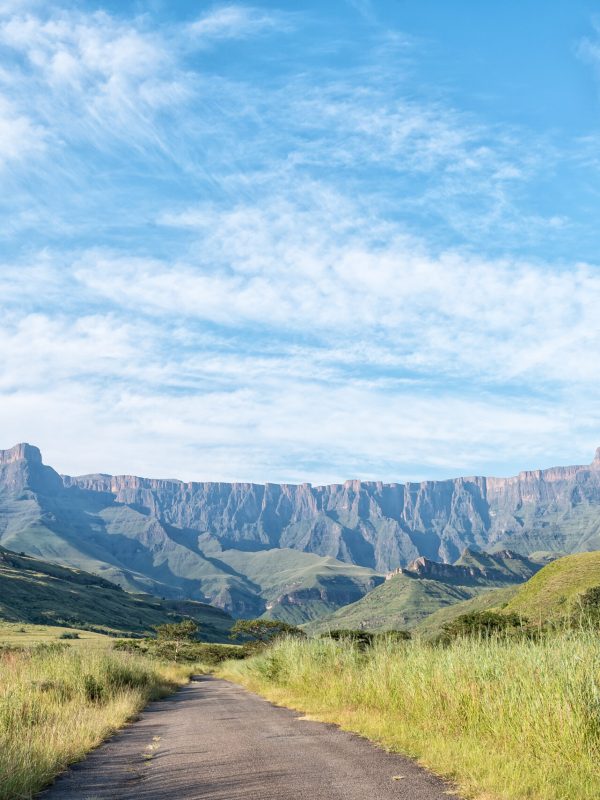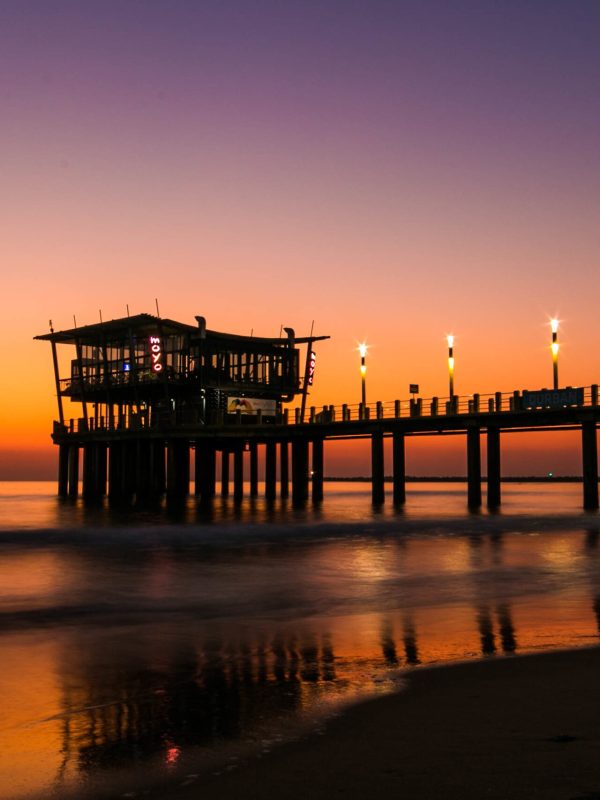KZN FILM COMMISSION > FILMING IN KZN
About KZN


The garden province of South Africa, KwaZulu-Natal is a subtropical region of lush and well-watered valleys, washed by the warm Indian Ocean. One of the country’s most popular tourist destinations, the province stretches from Port Edward in the south to the borders of Swaziland and Mozambique in the north.
Its western part is marked by the dramatic Drakensberg mountain range, with several peaks well over 3 000 metres. The range has been awarded World Heritage status for its dramatic natural beauty and the wealth of San Bushman rock art found in its caves – the richest concentration on the continent of Africa.
Between the mountains and the humid, subtropical coastline is savannah grassland, but there are also areas of indigenous forest along the coast. The largest of its many rivers is the Thukela.
It is a summer rainfall area, with a climate that ranges from extremely hot along the coast in summer, to heavy snow on the mountains in winter. The Midlands are drier than the coast and can be very cold in winter.
Its western part is marked by the dramatic Drakensberg mountain range, with several peaks well over 3 000 metres. The range has been awarded World Heritage status for its dramatic natural beauty and the wealth of San Bushman rock art found in its caves – the richest concentration on the continent of Africa.
Between the mountains and the humid, subtropical coastline is savannah grassland, but there are also areas of indigenous forest along the coast. The largest of its many rivers is the Thukela.
It is a summer rainfall area, with a climate that ranges from extremely hot along the coast in summer, to heavy snow on the mountains in winter. The Midlands are drier than the coast and can be very cold in winter.
Durban is one of the fastest-growing urban areas in the world. Its harbour is the busiest in South Africa and one of the 10 largest in the world. Every year the port of Durban handles over 30-million tons of cargo with a value of more than R100-billion. To the north of Durban, the port of Richards Bay, an important coal-export harbour, handles over 12 000 containers a year. Combined, the two ports account for some 78% of South Africa’s cargo tonnage.
The capital of KwaZulu-Natal is Pietermaritzburg. The province has several popular coastal holiday resorts, such as Port Shepstone, Umhlanga Rocks and Margate. In the interior, Newcastle is well-known for steel production and coal-mining, Estcourt for meat processing, and Ladysmith and Richmond for mixed agriculture. The KwaZulu-Natal coastal belt yields sugar cane, wood, oranges, bananas, mangoes and other tropical fruit.
The Land and Its People
With a total area of 94 361 square kilometres, KwaZulu-Natal is roughly the size of Portugal. While it’s the country’s third-smallest province, taking up 7.7% of South Africa’s land area, it has the second-largest population, estimated at 10.6-million people in 2010.
The principal language is isiZulu, followed by English and Afrikaans. Remnants of British colonialism and a mix of Zulu, Indian and Afrikaans traditions give the province a rich cultural diversity.
KwaZulu-Natal is the only province with a monarchy specifically provided for within South Africa’s Constitution. The province’s name comes from the Zulu kingdom of KwaZulu, previously a nominal (although never “independent”) homeland in the apartheid era, and the former British colony of Natal, later a province of South Africa.
KwaZulu-Natal has active conservation activities. The Royal Natal National Park is home to more than 1 000 plant species, 12 species of antelope and three of the world’s seven species of crane. Other reserves are Giant’s Castle and the Kamberg Nature Reserve.
Some of South Africa’s best-protected indigenous coastal forests are found along the subtropical coastline of KwaZulu-Natal, such as at Dukuduku and Kosi Bay. It is also along this coast that the magnificent iSimangaliso Wetland Park is found – along with the Drakensberg, one of KwaZulu-Natal’s two Unesco World Heritage sites.
The northern part of the province, on the Swaziland border, is typical African savanna, providing a natural backdrop for its rich wildlife, protected in several game parks.
The capital of KwaZulu-Natal is Pietermaritzburg. The province has several popular coastal holiday resorts, such as Port Shepstone, Umhlanga Rocks and Margate. In the interior, Newcastle is well-known for steel production and coal-mining, Estcourt for meat processing, and Ladysmith and Richmond for mixed agriculture. The KwaZulu-Natal coastal belt yields sugar cane, wood, oranges, bananas, mangoes and other tropical fruit.
KZN Coastline
The coastline is dotted with small towns, many of which serve as seasonal recreational hubs. The climate of the coastal areas is humid and subtropical, comparable to southern Florida in the United States, but not quite as hot and rainy in the summer. As one moves further north up the coast towards the border of Mozambique, the climate becomes almost purely tropical. North of Durban is locally referred to as “The North Coast”, while south is “The South Coast”. The Kwazulu-Natal Tourist board includes towns such as Margate, Port Shepstone,Scottburgh and Port Edward in its definition of the South Coast, while Ballito, Umhlanga and Salt Rock are North Coast resort towns.
Beaches of world-class quality are to be found along virtually every part of South Africa’s eastern seaboard, with some of the least-developed gems found in the far southern and far northern ends of the province. Marina Beach (and its adjoining resort San Lameer) was recognised in 2002 as a Blue Flag beach.
Some visitors come for the annual late autumn or early winter phenomenon on the KwaZulu-Natal coast of the “sardine run”. Referred to as “the greatest shoal on earth”, the sardine run occurs when millions of sardines migrate from their spawning grounds south of the southern tip of Africa northward along the Eastern Cape coastline toward KwaZulu-Natal. They follow a route close inshore, often resulting in many fish washing up on beaches. The huge shoal of tiny fish can stretch for many kilometres; it is preyed upon by thousands of predators, including game fish, sharks, dolphins and seabirds. Usually the shoals break up and the fish disappear into deeper water around Durban. Scientists have been unable to answer many questions surrounding this exceptional seasonal event.
Climate
KwaZulu-Natal has a varied yet verdant climate thanks to diverse, complex topography. Generally, the coast is subtropical with inland regions becoming progressively colder. Durban on the south coast has an annual rainfall of 1009 mm, with daytime maxima peaking from January to March at 28 °C (82 °F) with a minimum of 21 °C (70 °F), dropping to daytime highs from June to August of 23 °C (73 °F) with a minimum of 11 °C (52 °F). Temperature drops towards the hinterland, with Pietermaritzburg being similar in the summer, but much cooler in the winter. Ladysmith in the Tugela River Valley reaches 30 °C (86 °F) in the summer, but may drop below freezing point on winter evenings. The Drakensberg can experience heavy winter snow, with light snow occasionally experienced on the highest peaks in summer. The Zululand north coast has the warmest climate and highest humidity, supporting many sugar canefarms around Pongola.
Beaches of world-class quality are to be found along virtually every part of South Africa’s eastern seaboard, with some of the least-developed gems found in the far southern and far northern ends of the province. Marina Beach (and its adjoining resort San Lameer) was recognised in 2002 as a Blue Flag beach.
Some visitors come for the annual late autumn or early winter phenomenon on the KwaZulu-Natal coast of the “sardine run”. Referred to as “the greatest shoal on earth”, the sardine run occurs when millions of sardines migrate from their spawning grounds south of the southern tip of Africa northward along the Eastern Cape coastline toward KwaZulu-Natal. They follow a route close inshore, often resulting in many fish washing up on beaches. The huge shoal of tiny fish can stretch for many kilometres; it is preyed upon by thousands of predators, including game fish, sharks, dolphins and seabirds. Usually the shoals break up and the fish disappear into deeper water around Durban. Scientists have been unable to answer many questions surrounding this exceptional seasonal event.
KZN Borders
KwaZulu-Natal borders the following areas of Mozambique, Swaziland and Lesotho:
- Maputo Province, Mozambique (far northeast)
- Lubombo District, Swaziland (northeast, east of Shiselweni)
- Shiselweni District, Swaziland (northeast, west of Lubombo)
- Mokhotlong District, Lesotho (southwest, north of Thaba-Tseka)
- Thaba-Tseka District, Lesotho (southwest, between Mokhotlong and Qacha’s Nek)
- Qacha’s Nek District, Lesotho (southwest, south of Thaba-Tseka)
Domestically, it borders the following provinces:
- Mpumalanga (north)
- Free State (west)
- Eastern Cape (southwest)
Beaches of world-class quality are to be found along virtually every part of South Africa’s eastern seaboard, with some of the least-developed gems found in the far southern and far northern ends of the province. Marina Beach (and its adjoining resort San Lameer) was recognised in 2002 as a Blue Flag beach.
Some visitors come for the annual late autumn or early winter phenomenon on the KwaZulu-Natal coast of the “sardine run”. Referred to as “the greatest shoal on earth”, the sardine run occurs when millions of sardines migrate from their spawning grounds south of the southern tip of Africa northward along the Eastern Cape coastline toward KwaZulu-Natal. They follow a route close inshore, often resulting in many fish washing up on beaches. The huge shoal of tiny fish can stretch for many kilometres; it is preyed upon by thousands of predators, including game fish, sharks, dolphins and seabirds. Usually the shoals break up and the fish disappear into deeper water around Durban. Scientists have been unable to answer many questions surrounding this exceptional seasonal event.
Other Key Facts
The province of KwaZulu Natal is home to 10.2 million people, KZN borders the Indian Ocean, as well as three other provinces and the countries of Mozambique, Swaziland and Lesotho. KZN has third largest film industry in South Africa, worth R237.6 million per year. Durban is the fastest growing urban area in the world. Its harbour is one of busiest in South Africa and one of the 10 largest in the world.
KwaZulu Natal Province
Ranked 2nd in South Africa
Capital: Pietermaritzburg
Major City: Durban
Languages: 77.8% isiZulu, 13,2% English
Black 86.6%, Indian 7.4 %, White 4.2%, Coloured 1.4%
Population: 10 267 300 (2011)
20% of all tourists to South Africa visit KwaZulu Natal
Best transport system in SA – travel by road, rail, sea, and air
The principal language is isi-Zulu followed by English and Afrikaans. Remnants of British colonialism and a mix of Zulu, Indian and Afrikaans traditions give the province a rich culture.
Second Largest Economy in SA
- Bank Hours – 9-15:3-00pm
- Currency – Rand
Value Added Tax (VAT)
- 15% Tax is charged on most purchased goods and services. Reclaim on products over R250.00
Dube Tradeport Data Centre
Dube Tradeport , home of King Shaka International airport, a national key point is the location of the iConnect Data Centres situated approximately 50Km for Durban with points of presence of all major data carriers. A Secure Safe location for housing or distribution of data.
Our Technology Infrastructure
Durban is within 150kms of 3 Major Cable Landings
Fibre Optics connectivity through broadband cost effectively
Safety & Security
- Police & Flying Squad – 10111
- Ambulance – 10177
- Tourist Customer Service – 0860101099
- Train Enquiries (Spoornet) – 031 361 7883
- Airport Flight Info – 032 436 6644
- Dept. of Home Affairs – 031 331 9111
The Royal Natal National Park consists of over 1000 plants species. North KZN is rich in wild life, African Savanna. The Valley of Thousand Hills table mountain – 960m high. Drakensburg Mountains’ highest peak – ThabanNtlenyana – 3482 m. ISimangaliso Wetlands Park is a breathtaking mix of coral reefs, long sandy beaches, coastal dunes, lake systems, and extensive reed and papyrus wetlands. ‘Gateway’ is the largest shopping mall in Africa.




